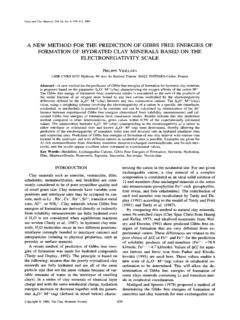Transcription of 1 Fully Convolutional Networks for Semantic Segmentation
1 1 Fully Convolutional Networksfor Semantic SegmentationEvan Shelhamer , Jonathan Long , and Trevor Darrell,Member, IEEEA bstract Convolutional Networks are powerful visual models that yield hierarchies of features. We show that Convolutional networksby themselves, trained end-to-end, pixels-to-pixels, improve on the previous best result in Semantic Segmentation . Our key insight is tobuild Fully Convolutional Networks that take input of arbitrary size and produce correspondingly-sized output with efficient inferenceand learning. We define and detail the space of Fully Convolutional Networks , explain their application to spatially dense predictiontasks, and draw connections to prior models.
2 We adapt contemporary classification Networks (AlexNet, the VGG net, and GoogLeNet)into Fully Convolutional Networks and transfer their learned representations by fine-tuning to the Segmentation task. We then define askip architecture that combines Semantic information from a deep, coarse layer with appearance information from a shallow, fine layerto produce accurate and detailed segmentations. Our Fully Convolutional network achieves improved Segmentation of PASCAL VOC(30% relative improvement to mean IU on 2012), NYUDv2, SIFT Flow, and PASCAL-Context, while inference takes one tenth ofa second for a typical Terms Semantic Segmentation , Convolutional Networks , Deep Learning, Transfer LearningF1 INTRODUCTIONCONVOLUTIONAL Networks are driving advances inrecognition.
3 Convnets are not only improving forwhole-image classification [1], [2], [3], but also makingprogress on local tasks with structured output. These in-clude advances in bounding box object detection [4], [5], [6],part and keypoint prediction [7], [8], and local correspon-dence [8], [9].The natural next step in the progression from coarse tofine inference is to make a prediction at every pixel. Priorapproaches have used convnets for Semantic Segmentation [10], [11], [12], [13], [14], [15], [16], in which each pixel islabeled with the class of its enclosing object or region, butwith shortcomings that this work show that Fully Convolutional Networks (FCNs)trained end-to-end, pixels-to-pixels on Semantic segmen-tation exceed the previous best results without furthermachinery.
4 To our knowledge, this is the first work totrain FCNs end-to-end (1) for pixelwise prediction and (2)from supervised pre-training. Fully Convolutional versionsof existing Networks predict dense outputs from arbitrary-sized inputs. Both learning and inference are performedwhole-image-at-a-time by dense feedforward computationand backpropagation. In- network upsampling layers enablepixelwise prediction and learning in nets with method is efficient, both asymptotically and ab-solutely, and precludes the need for the complications inother works.
5 Patchwise training is common [10], [11], [12],[13], [16], but lacks the efficiency of Fully convolutionaltraining. Our approach does not make use of pre- and post-processing complications, including superpixels [12], [14],proposals [14], [15], or post-hoc refinement by random fields Authors contributed equally E. Shelhamer, J. Long, and T. Darrell are with the Department of ElectricalEngineering and Computer Science (CS Division), UC Berkeley. local classifiers [12], [14]. Our model transfers recentsuccess in classification [1], [2], [3] to dense prediction byreinterpreting classification nets as Fully Convolutional andfine-tuning from their learned representations.
6 In contrast,previous works have applied small convnets without super-vised pre-training [10], [12], [13]. Semantic Segmentation faces an inherent tension be-tween semantics and location: global information resolveswhatwhile local information resolveswhere. What can bedone to navigate this spectrum from location to semantics ?How can local decisions respect global structure? It is notimmediately clear that deep Networks for image classifica-tion yield representations sufficient for accurate, the conference version of this paper [17], we castpre-trained Networks into Fully Convolutional form, andaugment them with a skip architecture that takes advantageof the full feature spectrum.
7 The skip architecture fusesthe feature hierarchy to combine deep, coarse, semanticinformation and shallow, fine, appearance information (seeSection and Figure 3). In this light, deep feature hierar-chies encode location and semantics in a nonlinear local-to-global journal paper extends our earlier work [17] throughfurther tuning, analysis, and more results. Alternativechoices, ablations, and implementation details better coverthe space of FCNs. Tuning optimization leads to more accu-rate Networks and a means to learn skip architectures all-at-once instead of in stages.
8 Experiments that mask foregroundand background investigate the role of context and on the object and scene labeling of PASCAL-Contextreinforce merging object Segmentation and scene parsing asunified pixelwise the next section, we review related work on deepclassification nets, FCNs, recent approaches to Semantic seg-mentation using convnets, and extensions to FCNs. The fol- [ ] 20 May 2016296384256409640962121backward/learni ngforward/inferencepixelwise predictionsegmentation 1. Fully Convolutional Networks can efficiently learn to make densepredictions for per-pixel tasks like Semantic sections explain FCN design, introduce our architec-ture with in- network upsampling and skip layers, and de-scribe our experimental framework.
9 Next, we demonstrateimproved accuracy on PASCAL VOC 2011-2, NYUDv2,SIFT Flow, and PASCAL-Context. Finally, we analyze designchoices, examine what cues can be learned by an FCN, andcalculate recognition bounds for Semantic RELATEDWORKOur approach draws on recent successes of deep nets forimage classification [1], [2], [3] and transfer learning [18],[19]. Transfer was first demonstrated on various visualrecognition tasks [18], [19], then on detection, and on bothinstance and Semantic Segmentation in hybrid proposal-classifier models [5], [14], [15].
10 We now re-architect andfine-tune classification nets to direct, dense prediction ofsemantic Segmentation . We chart the space of FCNs andrelate prior models both historical and Convolutional networksTo our knowledge, theidea of extending a convnet to arbitrary-sized inputs firstappeared in Matanet al. [20], which extended the classicLeNet [21] to recognize strings of digits. Because their netwas limited to one-dimensional input strings, Matanet Viterbi decoding to obtain their outputs.
![arXiv:0706.3639v1 [cs.AI] 25 Jun 2007](/cache/preview/4/1/3/9/3/1/4/b/thumb-4139314b93ef86b7b4c2d05ebcc88e46.jpg)

![arXiv:1301.3781v3 [cs.CL] 7 Sep 2013](/cache/preview/4/d/5/0/4/3/4/0/thumb-4d504340120163c0bdf3f4678d8d217f.jpg)
![@google.com arXiv:1609.03499v2 [cs.SD] 19 Sep 2016](/cache/preview/c/3/4/9/4/6/9/b/thumb-c349469b499107d21e221f2ac908f8b2.jpg)











